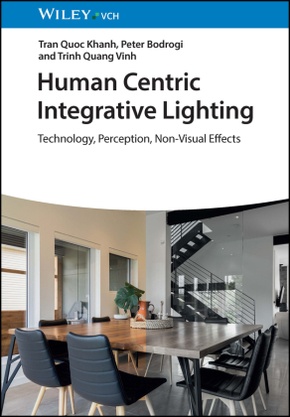Human Centric Integrative Lighting - Technology, Perception, Non-Visual Effects
| Verlag | Wiley-VCH |
| Auflage | 2023 |
| Seiten | 496 |
| Format | 17,8 x 2,8 x 25,4 cm |
| Gewicht | 1002 g |
| Artikeltyp | Englisches Buch |
| ISBN-10 | 3527414002 |
| EAN | 9783527414000 |
| Bestell-Nr | 52741400A |
The book deals with the highly topical research area of human centric interior lighting that connects technical aspects of lighting with their effect on humans.
Inhaltsverzeichnis:
1. INTRODUCTION
History of Lighting Engineering
Illuminating Engineering: Technological Challenges and Relevance to Society
Aims and Motivations of the Present Book
2. FUNDAMENTALS OF LIGHTING ENGINEERING - VISUAL AND NON-VISUAL ASPECTS
The Human Eye
Basic Quantities of Lighting Engineering: V(Lambda) Function, 2° and 10° Colour Matching Functions, Basics of Colorimetry, Colour Spaces, Colour Appearance Models, Colour Rendition Indices, Colour Gamut
Non-Visual Aspects: CIE 2015, DIN Spec 5031-100, Spectral Sensitivity Functions for Melanopsin, Melatonin Suppression According to Brainard and Thapan
The Metrics Amel According to DIN Spec 5031-100
Receptor Signals According to CIE 2018
Aging of the Human Eye According to DIN 5031-10
3. CONVENTIONAL INTERIOR LIGHTING PRINCIPLES
Design Recommendations According to CIE and DIN EN 12464
Lighting Quality Criteria, Specifications About Cri, Glare, Modelling Index, Homogeneity, Luminous Eff icacy, Shifts of White Point, Illuminance, Luminance
4. HCL PRINCIPLES FOR INTERIOR LIGHTING
What Is HCL: Definition with Three Components (Visual Performance, Psychological-Emotional Aspects and Non-Visual Aspects)
Visual and Non-Visual Mechanisms
Input and Output Parameters of the HCL System
Influencing Factors of the Effect of Light on Humans (Time of the Day, Time of the Year, Weather, Age, Gender) from the Lighting Engineer's Point of View
5. VISUAL PERFORMANCE
Visual Performance with the V(Lambda) Function: Relative Visual Performance (RVP) Model, Luminance Contrast, Reaction Time, Effect of Age
Modern Aspects of Brightness and Visual Clarity: New Experiments About Brightness and Visual Clarity, Models of Brightness and Visual Clarity, Comparison of Brightness Models
6. COLOUR QUALITY AND EMOTIONAL ASPECTS
Colour Quality: Colour Quality and Chroma Enhancement, Visual Experiments in a Viewing Booth and in a Real Room, Modelling of Colour Quality, Modelling of Colour Quality According to Luo, Houser, Wei, Royer, Effect of Red Oversaturation
Preferred White Points
Preferred Correlated Colour Temperatures
Preferred Ranges of Colour Temperature and Illuminance
7. CORRELATION ANALYSIS OF THE NUMERIC METRICS OF HCL
Mathematical Analysis of the Correlations Between the Three Groups of Metrics: Visual Performance, Colour Quality Metrics and the Descriptors of Non-Visual Effects
the Um Numeric Method (Um1-Um2) Characterizing the Usefulness of Light Sources
Correlation Between Brightness Metrics and Cs
8. NEW MODELS OF LIGHTING QUALITY FOR VISUAL AND NON-VISUAL EFFECTS
New Models of Lighting Quality of the Tu Darmstadt 2019 Predicting Visual Clarity, Colour Preference and Scene Preference from Illuminance Level, Correlated Colour Temperature, Circadian Stimulus and A Measure of Object Chroma Enhancement
9. CAUSE-EFFECT RELATIONSHIPS IN HUMAN CENTRIC LIGHTING
Evaluation of HCL Literature from 1990 Until Today
Analysis and Summary of Field Studies About HCL in Offices, Schools, Hospitals, Industrial Lighting and the Practice of Light Therapy
Identification of Relevant Cause-Effect Relationships
Recommendations for Practical Lighting Engineering Design
10. PRACTICAL LIGHT MEASUREMENT METHODS FOR HCL APPLICATIONS
Computational Method for the Value of the Circadian Stimulus (Cs) from Conventional Illuminance, Tristimulus and Correlated Colour Temperature Measurements
Personal Dosimetry: Measurement of Cs with Colorimeters
Spatially Resolved Light Measurements in Interior Space
11. DAYLIGHT
Exterior Measurements - Spectral Distribution of Radiation As A Function of Time of the Day and Time of the Year
Dynamics, Colorimetric and Circadian Characteristics
Effect of Daylight on Sleeping Quality, Alertness and Vitality
Detection and Reconstruction of Daylight
Daylight Compensati

